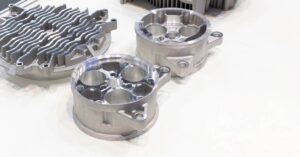Metal forming is a centuries-old art, and over the years, various techniques have been developed to achieve distinct results based on the intended application. Among these techniques, die casting is particularly popular. However, how does it measure up against other metal forming processes? Let’s explore further.
What is Die Casting?
Before diving into a comparison of die casting and other metals, let’s take a quick refresher on what die casting entails:
Process
Die casting is a method where molten metal is forced into a mold cavity under high pressure.
Materials
Typically, non-ferrous metals such as aluminum, zinc, and copper are used.
Applications
From automobile parts to toys, die casting is ubiquitous in creating intricate parts.
Pros of Die Casting: At a Glance
High-Speed Production
Die casting machines can produce aesthetically pleasing parts at a much faster rate than other methods.
Dimensional Accuracy
Offers tight tolerances and consistent dimensional results.
Smooth Finish
Parts usually require less machining and finishing post-production.
Economical
Especially for large production runs, die casting can be more cost-effective.
Drawbacks of Die Casting
Limited to Non-ferrous Metals
You’re restricted to metals like aluminum, zinc, and copper.
Initial Setup Cost
Setting up a die can be expensive, making it less suitable for short production runs.
Factors to Consider When Choosing a Metal Forming Process
- Volume of Production – If you’re looking at mass production, die casting might be your go-to. For smaller runs, other methods might be more cost-effective.
- Detail & Complexity – Need something intricate with a smooth finish? Die casting has an edge.
- Strength & Durability – If these are paramount, processes like forging might be more suitable.
While die casting offers a plethora of advantages, it’s essential to evaluate the specific requirements of your project. Every metal forming process has its strengths, and the key lies in matching those strengths to your project’s needs.
Comparison: Die Casting vs. Other Metal Forming Processes
Die Casting vs. Sand Casting
Speed & efficiency
While sand casting allows for the creation of large parts, it’s generally slower than die casting. The die casting process can produce a large volume of parts in a relatively short time.
Finish & detail
Sand casting can sometimes leave a rougher surface, requiring further finishing. Die casting, on the other hand, offers a smoother finish and can capture intricate details better.
Die Casting vs. Investment Casting
Cost-effectiveness
Investment casting, also known as lost-wax casting, can be more expensive due to the multi-step process involved. Die casting can be more cost-effective, especially for large production runs.
Material flexibility
Investment casting can be used with a broader range of metals, including ferrous metals. Die casting predominantly focuses on non-ferrous metals.
Die Casting vs. Forging
Strength & durability
Forged components generally boast superior strength and structural integrity. For applications that require high durability, forging might be preferable.
Complexity & design
Forging is not as suitable for extremely intricate designs as die casting. Die casting can produce more complex shapes with thinner walls.
Die Casting vs. Sheet Metal Forming
Sheet metal forming, a widespread method used in everything from automotive panels to kitchen utensils, contrasts quite a bit with die casting. Here’s how:
Material Thickness
While sheet metal forming, as the name suggests, works with sheets of metal, die casting involves the use of molten metal to fill molds. This means sheet metal parts are generally thinner.
Flexibility vs. Rigidity
Sheet metal forming can produce bendable, flexible parts (think of a metal spring). In contrast, die casting results in rigid components.
Surface Finish
While die casting naturally provides a smooth finish, sheet metal might need additional processes like sanding to achieve a similar result.
Die Casting vs. Extrusion
Extrusion, a process where the material is pushed through a die to create an elongated shape (like rods or tubes), offers some distinct comparisons.
Shape Complexity
Extrusion typically creates long, straight, uniform shapes. Die casting can yield more complex, non-linear forms.
Material Range
While die casting is limited mainly to non-ferrous metals, extrusion can also handle materials like plastic.
Die Casting vs. Powder Metallurgy
Powder metallurgy is fascinating, involving the use of metal powders to form parts.
Density & Porosity
Parts made from powder metallurgy can have controlled porosity, which can be beneficial for specific applications. Die cast parts are usually more dense and solid.
Material Utilization
Powder metallurgy can often make use of nearly 97% of the material with minimal waste, while die casting might have more wastage due to runners and overflows.
Final Thoughts: Making the Right Choice
Metal forming is an expansive field with each method offering its unique set of advantages.
To determine the best technique for your project:
Consider Your End Goal
Is strength, precision, volume, or cost your primary concern?
Material Preference
Your choice of metal can sometimes steer you towards one process over another.
Tooling and Setup Costs
For some processes, initial costs can be steep. Will you produce enough volume to justify it?
Understanding the nuances of each process ensures you harness their strengths effectively. If you want to know whether die casting is right for you, contact our experienced team today and let’s discuss your project!






